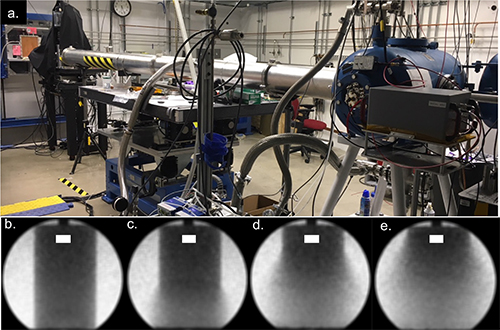
Nanoscale diamonds are used in a broad array of applications, including optical or quantum computing, sensors, and biomedicine. However, these materials, known as nanodiamonds, are difficult to efficiently synthesize and isolate. One way to generate nanodiamonds is through oxygen-deficient detonation of carbon-rich, explosive compounds. This method reliably produces ~4-nm nanodiamonds, but the resulting particles are always aggregated together and intertwined with graphitic and other unwanted phases of carbon. Techniques to separate out individual nanodiamonds, such as sonication with agents that break up and stabilize particles, can change their surfaces and adversely affect their properties. Because little is known about the aggregation kinetics of detonation nanodiamonds, or even their formation or aggregation mechanisms, it’s unclear whether it might be possible to implement interventions that prevent aggregation. To help elucidate the aggregation process, researchers from the U.S. Department of Energy’s (DOE’s) Lawrence Livermore Laboratory (LLNL) and Washington State University used the DOE’s Advanced Photon Source (APS) to track nanodiamond formation and aggregation over time. Their findings – published in the Journal of Physical Chemistry Letters – suggest that because nanodiamond aggregation happens at nearly the same time as nanodiamond formation, aggregation may be difficult to completely prevent.
The researchers studied formation and aggregation using two explosive mixtures known to produce detonation nanodiamonds: a mixture of hexogen (RDX) and trinitrotoluene (TNT) known as comp B, and a mixture of octogen (HMX) and TNT known as octol. They also studied two explosives that produce graphitic carbon allotropes: DNTF (3,4-bis(3-nitrofurazan-4-yl)furoxan) and UFTATB (2,4,6-triamino-1,3,5-trinitrobenzene). Each of these compounds was pressed into a cylinder and detonated inside a tank while time-resolved small-angle X-ray scattering (TR-SAXS) data was collected at the Dynamic Compression Sector (35-ID) at the APS.
Transmission electron microscopy on recovered detonation products showed that each of the four explosives produced a diverse range of carbon nanomaterials. While ribbon-like aggregates dominated the UFTATB products and distinct nano-onion structures dominated the DNTF products, the main products of comp B and octol were detonation nanodiamond aggregates.
Hierarchical scattering seen in the time-resolved small-angle scattering during detonation suggest the nanodiamonds aggregate rapidly: as early as 0.1 ms after the detonation front passes the x-ray measurement position.
Modeling experiments indicated that this phenomenon is consistent with classical diffusion-limited aggregation mechanism in colloids, suggesting that the detonation nanodiamond particles immediately attach to each other when they collide in this high-pressure, high-temperature environment. These aggregates may condense from an extended network of carbon structures, especially in the case of mixed explosives such as comp B and octol in which excess carbon is primarily supplied by only one of the components (TNT for both mixtures). Thus far, only DNTF products remain as distinct, non-aggregated spherical nanoparticles under the conditions measured to several microseconds post-detonation.
These results suggest that nanodiamond aggregation may be difficult to avoid from current detonation methods, since particle attachment occurs through irreversible chemical bonding rather than electrostatic interactions. Because the nano-onions from DNTF detonation don’t tend to aggregate, it may be possible to draw inspiration from their formation mechanism to develop new ways to synthesize isolated detonation nanodiamonds. ― Christen Brownlee
See: Joshua A. Hammons1*, Michael H. Nielsen1, Michael Bagge-Hansen1, Sorin Bastea1, Chadd May2, William L. Shaw1, Aiden Martin1, Yuelin Li2, Nicholas Sinclair2, Lisa M. Lauderbach1Ralph L. Hodgin1, Daniel A. Orlikowski1, Laurence E. Fried1, and Trevor M. Willey1**, “Submicrosecond Aggregation during Detonation Synthesis of Nanodiamond,” J. Phys. Chem. Lett. 21, 5286 (2021). DOI: 10.1021/acs.jpclett.1c01209
Author affiliations: 1Lawrence Livermore National Laboratory, 2Washington State University
Correspondence: * [email protected], ** [email protected]
This work was funded in its initial stages by LLNL LDRD 14-ERD-018 and in its latter stages by the U.S. Department of Energy’s (DOE’s) National Nuclear Security Administration’s (NNSA’s) Office of Defense Nuclear Nonproliferation and Science Campaign 2 and was performed under the auspices of the U.S. DOE by Lawrence Livermore National Laboratory under contract DE-AC52-07NA27344 (LLNL-JRNL-820295). The Dynamic Compression Sector is operated by Washington State University under the U.S. DOE/NNSA award no. DE-NA0003957. TEM work utilized the Molecular Foundry, a U.S. DOE User Facility operated for the DOE Office of Science by Lawrence Berkeley National Laboratory under contract no. DE-AC02-05CH11231. M.H.N. acknowledges support from the Lawrence Fellowship. This research used resources of the Advanced Photon Source, a U.S. Department of Energy (DOE) Office of Science User Facility operated for the DOE Office of Science by Argonne National Laboratory under contract no. DE-AC02-06CH11357.
The U.S. Department of Energy's Advanced Photon Source at Argonne National Laboratory is one of the world’s most productive x-ray light source facilities. Each year, the APS provides high-brightness x-ray beams to a diverse community of more than 5,000 researchers in materials science, chemistry, condensed matter physics, the life and environmental sciences, and applied research. Researchers using the APS produce over 2,000 publications each year detailing impactful discoveries, and solve more vital biological protein structures than users of any other x-ray light source research facility. APS x-rays are ideally suited for explorations of materials and biological structures; elemental distribution; chemical, magnetic, electronic states; and a wide range of technologically important engineering systems from batteries to fuel injector sprays, all of which are the foundations of our nation’s economic, technological, and physical well-being.
Argonne National Laboratory seeks solutions to pressing national problems in science and technology. The nation's first national laboratory, Argonne conducts leading-edge basic and applied scientific research in virtually every scientific discipline. Argonne researchers work closely with researchers from hundreds of companies, universities, and federal, state and municipal agencies to help them solve their specific problems, advance America's scientific leadership and prepare the nation for a better future. With employees from more than 60 nations, Argonne is managed by UChicago Argonne, LLC, for the U.S. DOE Office of Science.
The U.S. Department of Energy's Office of Science is the single largest supporter of basic research in the physical sciences in the United States and is working to address some of the most pressing challenges of our time. For more information, visit the Office of Science website.
